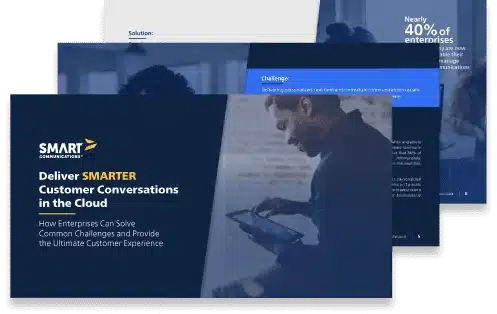4 Ways Forms Automation Can Enhance the Healthcare Member Experience
By: John Zimmerer, VP of Healthcare Marketing at Smart Communications
It’s said that repetition is the key to mastery. With this in mind, anyone who has visited a doctor’s office or filed a claim with their health insurer should be an expert at filling out paperwork. Given all the advances elsewhere in healthcare, it sounds silly, right? Perhaps, though, not as silly as the fact that people are still expected to complete the same paperwork online and in-person. This certainly isn’t a great way to meet the expectation of helping consumers be seen and known as individuals. There is, however, an opportunity for insurers to become experts at creating an exceptional healthcare member experience.
In the case of manual processes and paper forms, the repetitive nature is more of a headache than anything else—for both payers and members alike. This approach has proven to be unsustainable and unsuccessful for meeting members’ needs and enhancing their trust in health insurers. Simply put, member expectations have exceeded the capabilities provided by static forms and one-way communications. Health insurers must rethink how they engage with members and adopt solutions that enable interactive, two-way conversations.
When it comes to optimizing the healthcare member experience and building loyalty, unfortunately it’s time for health insurers to play catch up. To dive into the topic a bit more, we commissioned Forrester to conduct research into the current state of member experience. The resulting report, Disjointed Experiences Cost Insurers Members and Money: The Bleak Reality of Member Experience with US Health Insurers, highlights the opportunities available for health insurers to make improvements to each stage in a member’s journey, such as collecting member information. Something to keep in mind: when we refer to the member journey, this is the typical pathway members take with an insurer—engaging with touchpoints along the way—to achieve a particular goal.
Fortunately, there are technology resources available today that can take the member experience to a new level nearly immediately. SmartIQ, for example, gives health insurers a competitive advantage and the ability to quickly implement or extend a digital-first strategy. Using a forms automation solution helps to digitize, optimize and modernize the forms process across the healthcare member experience.
This article dives into the tangible benefits of digital forms and specifically highlights how health insurers can:
- Enhance the healthcare member experience by making meaningful, incremental improvements
- Drive down call volume and improve the member experience with claim-related forms
- Transform the manual, paper-based processes to digital, intuitive experiences
- Optimize the processes for member-submitted claims and adjudication
1. Use Low-Code Solutions to Eliminate Manual Forms
In healthcare, forms are everywhere and at every stage of the member lifecycle. While forms are just one stage of a member’s journey, they’re often the most important. They can provide a starting point for two-way, interactive conversations—giving insurers the ability to gain deeper insight into their members’ needs and expectations and respond in a manner that’s personalized and meaningful.
The process for gathering the necessary member data isn’t always easy or efficient—especially since paper forms lack the interactivity that drives rich, in-depth engagement and the ability for payers to meet members wherever they are. Research even showed that nearly 60% of consumers abandon a form if the process is too difficult. Even worse, manual processes create a transactional relationship between member and payer which isn’t ideal for an industry as intimate as health insurance.
A low-code forms automation solution helps health insurers enhance member engagement by paving the way for a better end-to-end experience. It removes the additional hoops that consumers must jump through when filing or appealing claims. Eliminating manual forms in favor of digital solutions creates a less burdensome member experience and improves operational efficiency for the payer. With digital processes in place, payers can focus on building member loyalty and trust through empathetic conversations at every interaction.
A person’s health and financial security are both intensely subjective and personal topics. And, depending on an individual’s situation, there’s no shortage of emotions when members interact with payers. That’s why it’s key to create easier ways for members to submit information in critical journeys like submitting claims and filing appeals. This will reduce the level of stress and anxiety during these engagements.
RELATED READING | ‘Eliminate Healthcare Forms and Boost Member Satisfaction with Cloud Technology’
2. Improve the Healthcare Member Experience with SMARTER Conversations
The key to improving member engagement is creating more seamless, efficient interactions. Static or fillable PDFs and web forms don’t allow payers to nurture interactive conversations that provide the deeper insights they need to meet members’ needs.
As previously mentioned, the health insurance industry is lagging in digital transformation—a fact that’s creating friction in attracting new members and keeping them loyal. Improvement starts with identifying and measuring key member journeys, with the goal of prioritizing changes. Through this audit, organizations can identify processes and functions that may benefit from automation, specifically looking for opportunities to make incremental improvements. These are often manual tasks, such as responding and following up on claims-related interactions. Automating these processes can enhance both the member and employee experiences.
The opportunity to improve the healthcare member experience is perhaps most visible within the claims process. Members submit claims for a variety of reasons. One common type of claim is a request for reimbursement for covered items purchased over the counter. Requests for reimbursement for COVID-19 test kits are a great example of how insurers should modify existing processes to comply with new and changing mandates. Using cloud technology to tackle these types of reimbursement requests will result in faster settlement times and ultimately, happier members and employees.
YOU MIGHT ALSO LIKE | ‘Optimize Digital Forms for COVID-19 Claims’
3. Enable Intelligent Conversations for Claims Appeals
Despite a health insurer’s best efforts, there are occasionally issues with how claims are adjudicated. Sometimes, the issue is related to the timing of when claims are received versus the chronological order of dates of service. When something is amiss, a member will want to appeal the initial determination.
Unfortunately, there are several problems with the current state of claims appeals. When questions arise, members are often asked to contact the call center and are then instructed to submit a generic appeal form to request a redetermination. This form is an important step along the claims redetermination pathway.
But what happens when agents are bogged down or lack the training necessary to help members solve even this basic problem? Furthermore, often completing the necessary forms are highly manual efforts for both payer and member and unfortunately do not include any pre-populated, known information based on the member’s information or specific claim.
This immediately leads to member dissatisfaction, lack of trust and inability for members to self-service a claims appeal. Even though Forrester has found speaking on the phone was the most reliable channel for members, that same research shows that 51% were dissatisfied with their experience with the call center.
After contacting the call center, members may have a difficult time simply finding an appeal form. Once they do find the correct form, there’s an additional headache of filling out and submitting the form. This method forces a member to print and mail or fax the form (along with supporting documents) to the insurance company and wait for a response. It’s inconvenient for both the payer and member as it adds additional time to get to a resolution.
There are many other pitfalls to this approach, such as:
- Members skipping a required field or forgetting an attachment
- Issues with imaging and processing the form, which leads to incomplete or inaccurate information being entered and processed on the business side
- Members accidentally sending the form to the wrong address or the form being lost in transit
- Incomplete forms, which leads to delays and increases frustration for member and operational expenses for the payer
Alternatively, and ideally, the appeal form should be an intelligent interview providing a guided member experience. A link to the interview can be embedded directly into the explanation of benefits. That way, all the data related to a specific claim can be pre-populated, allowing the member to focus on the reason for requesting a redetermination. The member can easily download a copy of the form and a copy can be attached to a case for review by an Appeals and Grievances member. With this approach, insurers can effectively communicate via the member’s channel of choice and maintain all communications seamlessly.
4. Automate the Healthcare Forms Process with Cloud Technology
The need and desire to automate processes continues to spread across most enterprises. This evolution has been integral to the success of workforces. In industries like healthcare, however, disjointed systems continue to create siloed approaches to even the simplest processes.
Cloud technology has made easier work of implementing automated solutions, as well as refining digitized business processes. Considering the healthcare forms process, some benefits of automating with cloud technology are:
Improved healthcare member experience
When automated, the healthcare member experience is transformed from a ‘hunt and hope’ approach to a personalized, ‘how may we help you?’ conversation. The payer already has access to the data in their systems of record without the need for the member to re-enter previously provided information. Interactions are member-led throughout the entire process and broken down into bite-sized chunks that are easily consumable. Since files, images or receipts can easily be attached, there’s no need to print, fax or mail anything. An e-signature process delivers digital data to all stakeholders. This results in improved CAHPS/HEDIS (STAR ratings), CX Index and NPS scores. And, most importantly, a reduction in burden on the member.
Increased efficiency throughout the claims process
Insurers can use the same technology to reimagine member-submitted claims. By moving business logic up front and limiting the amount of data entry required through integration with systems of record, fewer claim forms are rejected and reprocessed. Starting and staying digital means payers can eliminate scanning and using OCR software on physical forms. Ultimately, this reduces processing times and improves financial performance across the organization.
Lower regulatory risk
Using a truly digital forms solution, more member-submitted claims can be auto-adjudicated. Member-submitted claims can easily be paid within regulated timeframes, typically 30 days from receipt, reducing the risk of escalated appeals or grievances. This also eliminates fees, fines or penalties, as well as a negative reputation or public relations issues.
Conclusion
As health insurers identify ways to enhance the member experience, it all must start by understanding members as individuals – meeting them where they are and providing interactions that are tailored and relevant. Digitizing form-based processes, for example, can meaningfully move the needle on the end-to-end member experience. Give members a chance to rebuild trust in the healthcare industry by deploying sophisticated cloud technology to meet them at any time or place.
Forms automation solutions like SmartIQ provide near-term benefits in a long-term digital transformation journey—something that is desperately needed to remove all barriers to better member conversations. This will optimize the member experience and help employees on the insurers’ claims teams foster exceptional interactions at every touchpoint across the entire member experience.
It’s safe to say that automated solutions powered by cloud technology are critical to creating memorable experiences that boost member engagement and foster a level of care that insurers can be proud to offer their consumers.
Now that’s a process worth repeating.



